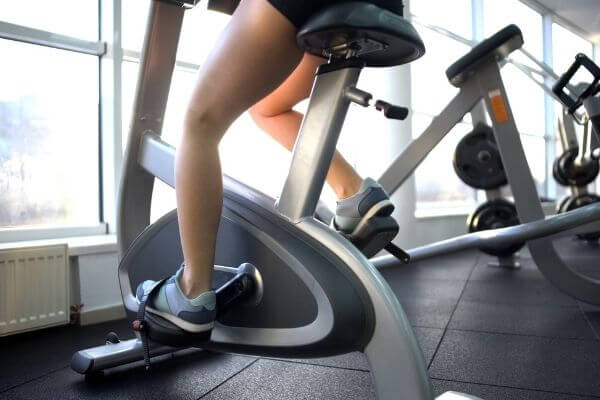Are you thinking about starting to exercise but don’t know which type of bike is the best for you? You’re on the right page. In this post, we’ll compare the recumbent vs upright bike and help you decide which one is right for you.
And as usual around here, we’ll focus on your needs first.
Keep reading to learn more!
Table of Contents
Benefits of Recumbent Bike
There are many benefits to riding a recumbent bike, including improved comfort and posture, back protection, and decreased stress on the joints.
Recumbent bikes put the rider in a semi-reclined position, which helps distribute weight more evenly and alleviates pressure on the spine and neck. This position also allows for better pedaling efficiency and reduced knee strain. In addition, recumbent bikes offer a more comfortable ride thanks to their larger seats and backrests.
And because you’re seated lower to the ground, recumbent bikes are more stable than traditional upright bikes.
Benefits of Upright Bike
Though often seen as the “less cool” choice when compared to Peloton bikes and other at-home exercise equipment, the upright bike has a lot to offer in terms of health benefits. For starters, upright bicycles are low-impact, meaning they put less stress on your joints than other forms of cardio, like running.
They’re also great for building leg muscle and improving your balance and coordination.
And if you suffer from back pain, you’ll be happy to know that riding an upright bike can help strengthen your back and improve your posture. So if you’re looking for a workout that’s easy on your body but still provides plenty of health benefits, an upright bike is a great choice.
Upright bikes have several advantages over recumbent ones too:
- They tend to be more compact and easier to store than recumbent bikes.
- They offer a larger range of motion, making them ideal for interval training or other high-intensity workouts.
- Upright bikes tend to be more affordable than recumbent bikes.
When it comes to choosing the right bike, it ultimately comes down to personal preference.
Recumbent Bike vs Upright: Muscles Worked

All your body muscles count, so let’s analyze what these bikes can do for them:
Legs
Recumbent bikes work the same muscles as upright bikes but in different proportions. For example, recumbent bikes emphasize the hamstrings and glutes, while upright bikes work the quadriceps and calf muscles more.
Core
One of the great debates in indoor cycling is over which type of bike is better for working the core muscles: recumbent or upright? While both have their proponents, the research on this question is far from conclusive.
However, some studies suggest that recumbent bikes may be more effective for people with back pain, as they put less strain on the spine. In addition, recumbent bikes tend to be more comfortable than upright bikes, and they engage your lower abs quite well.
On the other hand, upright bikes may provide a better workout for your upper abs and lower back muscles.
Arms
When pedaling a recumbent bike, your arms are not required to do any work. On the other hand, your arms are responsible for stability on an upright bike. As a result, they have to bear a fair amount of weight, increasing engagement and muscle tone.
Recumbent bikes have an advantage too:
The position of their handlebars keeps your arms relaxed and in a natural position, while the handlebars on an upright bike can put a strain on your wrists and elbows. So if you’re looking for a workout that will give your wrists and shoulders a break, a recumbent bike is the way to go.
However:
Remember that having a healthy body means working out all of your muscles. If you didn’t purchase a stationary bike with resistance bands, add some separate upper body strength training to your routine.
Pro tip: Purchase an upright or recumbent bike with built-in armbands to exercise your arms more.
Upright vs Recumbent Bike: Calories Burned

The recumbent bike is not as effective as the upright bike in terms of calories burned.
In general, you can expect to burn about 300 calories per hour on a recumbent bike and 600 calories per hour on an upright bike. Still, it’s essential to remember that these are only estimates.
Increasing the resistance and pedaling faster will burn more calories on a recumbent bike than on an upright bike.
Besides, your actual calorie burn will depend on your weight, level of fitness, and the intensity of your workout. So if you’re looking to burn more calories, don’t be afraid to crank up the resistance and pedal hard!
Upright Bike vs Recumbent for Weight Loss
Upright bikes burn 600 calories per hour, while recumbent bikes burn 300 calories. But that’s not the whole picture.
Cranking up the resistance on your recumbent bike may add muscle strength. As a result, your metabolic rate will increase, and you can burn more calories even at rest.
Read more: Recumbent Bike for Weight Loss: How to Shed Pounds Quickly
Conversely, you can do HIIT better on an upright bike to burn more calories and increase your metabolism.
So, which is best for weight loss?
It depends on your goals. If you’re looking to burn calories, an upright bike is the better alternative. But if you’re looking to build muscle and boost your metabolism, then a recumbent bike is better.
Recumbent or Upright Bike for Knees

Not only does a recumbent bike put less strain on your knees, but it also allows you to sit back and protect your back.
So, technically, a recumbent bike is better for your knees.
However, you can also make an upright bike knee-friendly by decreasing resistance and speed. In this case, you will lose fewer calories.
So:
- Choose a recumbent bike if you have chronic knee pain and want to lose weight safely.
- If you don’t have any knee pain and want to maintain joint health, an upright bike can be even more effective because it’s more weight-bearing.
As always, consult with your doctor before starting any new exercise regimen.
Read more: Are Exercise Bikes Bad for Your Knees?
Upright or Recumbent Bike for Glutes

It’s no secret that many people use indoor cycling to tone their glutes.
And while there’s no doubt that cycling can be an excellent workout for your behind, the question remains: is an upright or recumbent bike better for targeting your glutes?
First, let’s look at how each type of bike affects your glute muscles.
On an upright bike, you’ll primarily use your gluteus maximus, the largest muscle in your butt. This muscle is responsible for extending your hip, and it’s often the one that people focus on when they’re trying to build a bigger butt.
On a recumbent bike, on the other hand, you’ll use your gluteus medius and minimus. These muscles are smaller than the gluteus maximus, but they’re still crucial for moving your legs and stabilizing your hips.
So which type of bike is better for toning your glutes?
The answer may surprise you.
While recumbent bikes target your glutes more effectively than upright bikes, ultimately, resistance determines how much muscle you build. So if you’re looking to maximize your results, you should increase that resistance to challenge yourself.
Pro tip: Ensure your indoor bike has plenty of built-in programs focusing on your glutes if your goal is to increase their size.
Read more: Do Exercise Bikes Tone Your Bum?
Wrap Up
So, there you have it! A quick breakdown of the differences between recumbent bikes and upright bikes.
As you can see, each type of bike has its unique benefits. So whether you’re looking to burn more calories, lose weight, tone your glutes, or protect your knees, there’s a perfect bike out there for you.
Remember to consult with your doctor before starting any new exercise regimen, and happy cycling!
- How To Avoid Weight Loss Plateaus - July 9, 2024
- 5 Common Weight Loss Mistakes - July 9, 2024
- Walking vs Running: Weight Loss, Fat Loss, Life Span AND MORE - July 9, 2024

